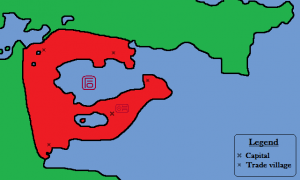Nokeo
| Keo | |
| Alternative Names | Nokeo |
| Author | Hakaku |
| Type | Savukk Collaborative Conworld Project |
| Year began | 2007 |
| Demonym | Ana (the) |
| Capital | Nomea |
| Demographics | |
| Population | 2 000 000 (with up to ~4 500 000 outside map borders) |
| Density | ~1.54/km² |
| Official languages | Nãwe |
| Number of speakers | 97% of the population |
| Minority languages | Anaye |
| Number of speakers | 4% of the population |
| Government | |
| Type | Moderate Neo-Tribalism |
| Political leader | Nowea |
| Establishment | |
| Year | 200 before year zero |
| Area | |
| Total | 2 434 929 km² |
| Land | 1 297 642 km² |
| Water | 1 137 287 km² |
| edit | |
Nokeo [nokeo] is a country situated in the Southeastern region of Savukk. While its official name is Keo [keo], literally meaning endless or sea, it is more colloquially known as Nokeo, formed from the honorific no- and keo, though it has also been adapted by other nations as an official term.
Contents
General Information
The land of Keo is situated in the South-East of Savukk, between Cámas and Elethke(†). It is one of the world's largest wetland lowlands, while further to the North, elevations create some forested areas. (see landscape). Occasionally, both heavy rainfalls and the tide of the bay, found in the center of Keo, may engulf surrounding lands causing floods.
The lowlands' landscape consists of a complex water system, ranging from ponds, to swamps, to bogs, marshes, rivers, permafrost, muskegs, etc. As for the ground, it consists mainly of peat lands, and nutrient poor soil. During winter, most of the surface area will be covered in ice and snow, while in the summer it will have thawed and melted away. Due to this varying environment, heavy equipment and objects are at a disadvantage, which renders light and durable objects more effective.
Comparatively, the people of Keo are much less advanced technology-wise than most civilizations around the globe. They are very ignorant to outsiders, only relying on trade in order to survive. Some may even consider their ways tribal or primitive, but this is the best way for anyone to survive and adapt in such a limited environment. However, they not only survive on trade, but they are also very skilled in medicine due to the vast amount of types of plants that thrive in the swamps. The kena, a plant whose flower can be seen on the national flag, is one of the most abundantly growing plants around. After they are pollinated, they will start producing palm-sized fruits. The kena's fruit is renowned for its ability to heal various diseases and infections, which are themselves often caused by bacteria thriving in the wetlands.
Government
Leader
The highest political figure of Keo is called the Nowea. He is a leader who generally plays the role of an ambassador, representing the people, and establishing simple common laws to be followed. However, as with tribes, the leader cannot leave his own land. Instead, he will appoint a particular person as a messenger in order to fulfill the Nowea's duties as an ambassador.
History
The origins of how Keo became a nation are still unclear. To the people who speak Nãwe, Keo has always been their land, literally meaning endless when describing water masses. It is assumed however, that roughly 200 years ago, a common agreement came about to form a single nation, since the uprisings in the North seemed a threat to the stability of their lands and trade.
In order to establish claim to the land and unify the people of Keo, or the Ana, a form of government had to be formed. Since the only thing known to them is tribalism, that is, small communities or groups which usually rely on a single leader and their own set of rules, the government would be based on such a system. Thus, moderate neo-tribalism was developed. In essence, the first Nowea (leader) devised a way where people could live separate personal lives back within their own tribes or communal groups, while still attending work and an otherwise partly modernized life, or in times of need, protecting the nation and their leader. The government is generally supported by trade taxes, where a portion of trade revenues are collected from trade villages and transferred to the capital.
The overall aspect of a governing system is still unknown or ignored by many of its inhabitants, especially since the formation of the government was followed by a time of peace in the North. Furthermore, internal conflicts are traditionally dealt by a trade between the two or more groups involved, and thus a government is often seen as unnecessary.
Economy
Up until 200 years before year zero, economy in Keo was strongly driven by fur and medicine trading, and wood cutting. However, since the foundation of the nation, the Nowea began to realise his vision of a greater trade on a world-wide perspective. Despite lacking better transportation, many common traders also endorsed this vision. However, international trade up to date has been all but easy, partly in cause by the Ana's reserved culture and reluctance to foreign goods. Regardless of that, future international trade and prosperity are expected to increase, as Keo's political stance remains limited on foreign affairs.
International Trade
As the people of Keo depend on a lifestyle consisting primarily of trade, Nokeo's international trade consists of two factors : Import and Export. Main exports generally constitute the trade of various meats (e.g. whale), fish, fur, wood, medicine, fruits, and fossil fuels. Imports may vary from region to region, but in general, Nokeo seeks various lightweight metals, breads, tools, and other intricacies. The most notable and reputed trades can be made in either of four trade villages, which are situated along the four corners of the land, and in the capital, Nomea. Foreign traders, as well as common traders, are often welcomed in these areas.
Environment
Climate and Biome
Keo is primarily situated in the Southeastern lowlands, found in Savukk's Southern taiga biome.
Landscape
The Southeastern lowlands stretch along the coast of Keo and further inland. This landscape is characterized by vast tidal flats and inland beach ridge complexes that provide highly productive freshwater marshes, sedge meadows and swamps. Bogs and fens are a dominant landscape feature further inland.
Further towards the North, is a more elevated terrain with warmer and drier temperatures, allowing boreal forests to thrive. Common threats to the latter include deforestation and occasional flooding.
Culture
To be expanded

